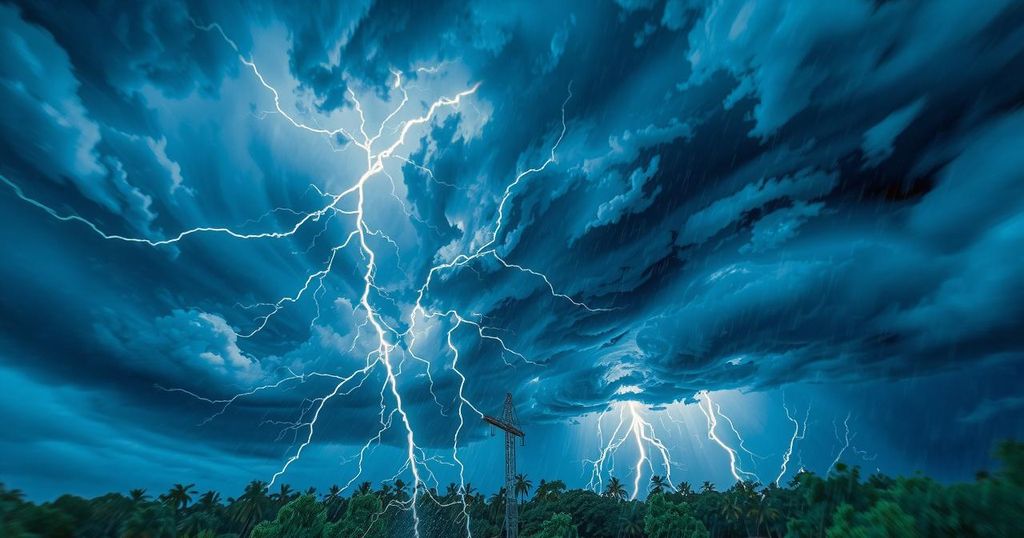Experts Warn of Deadly Thunderstorm’s Ties to Unusual Weather Patterns in Northern India

A severe thunderstorm in northern India resulted in 59 deaths, attributed to unusual weather patterns driven by persistent Western Disturbances and atmospheric disruptions linked to Arctic warming. Meteorologists warn of potential long-term impacts on the monsoon system, emphasizing the need for monitoring changes in weather dynamics.
An intense thunderstorm that swept through northern India on Wednesday has tragically resulted in at least 59 fatalities across two states. The storm, which sent shockwaves through communities, was attributed to a confluence of bizarre weather patterns, significant atmospheric disturbances, and unusual winter influences that the meteorological community had not anticipated at this time of year.
Meteorologists have described this severe weather as a product of what they call a “complex atmospheric cocktail.” This includes several cyclonic circulations working together, as well as ample moisture from both the Bay of Bengal and Arabian Sea, and extreme daytime heating. The persistence of Western Disturbances—traditionally winter-migrating storms—into the summer months has further complicated the monsoon landscape. M. Rajeevan, the former secretary of the ministry of earth sciences, emphasized the ongoing impact of these disturbances, noting that they are typically expected to retreat by the end of spring but have been lingering longer than normal.
Moreover, the unusual climatic trends may be linked to anomalies in the Arctic region where record heat is sending cold air southward, which affects weather systems globally. Notably, northern regions, including parts of Iceland, have reported unseasonably high temperatures, leading experts to draw parallels between these Arctic patterns and the ongoing weather events in India.
While Wednesday’s storm resulted from a combination of localized factors, Rajeevan pointed out that the cyclonic activity and high temperatures created substantial atmospheric instability. This instability—akin to bubbles in a boiling pot—can lead to severe storms and heavy rainfall. Notably, he remarked that the occurrence of such conditions, while somewhat uncommon, is not entirely without precedent.
Authorities from the India Meteorological Department (IMD) confirmed that no active Western Disturbance was affecting northwestern India at the time of the storm, which led to mixed interpretations among meteorological experts. Mahesh Palawat of Skymet explained that these cyclonic circulations can indeed be regarded as mild forms of Western Disturbances that have shifted in their behavior and impacts.
In the aftermath of the storm, victims included individuals from various backgrounds, including a 65-year-old man in Saharanpur and a six-year-old girl in Sonbhadra, highlighting the tragic and widespread nature of the fatalities. Infrastructure failures and falling trees exacerbated the situation, leading to additional casualties, such as the death of a motorcycle constable in Bijnor.
The storm was particularly fierce in Delhi, where wind speeds neared those associated with cyclonic storms. The rapid temperature drop—from 37 degrees Celsius to 23 degrees in just one hour—coupled with significant rainfall, disrupted transportation services, leading to flight diversions and metro delays.
As the weather situation evolves, a low-pressure area in the Arabian Sea is expected to intensify, potentially paving the way for an early monsoon onset in Kerala. However, Rajeevan cautioned that continuing Western Disturbances may impede the monsoon’s proper progress, suggesting that these atmospheric patterns could be indicative of larger climate changes at play.
The deadly storm serves as an urgent reminder of the interconnectedness of global weather systems. Escalating Arctic temperatures and the resultant shifts in weather dynamics could have profound effects not only on India’s climate but also on its agricultural landscape and urban infrastructure—a reality that requires attention as global temperatures continue to rise.
In conclusion, the recent deadly thunderstorms in northern India illustrate the far-reaching impacts of climate change and shifting weather patterns. At least 59 fatalities have raised alarms among meteorologists about the persistence of unusual winter influences complicating the monsoon cycle. Expert commentary, particularly from M. Rajeevan and Mahesh Palawat, highlights the urgent need to monitor these atmospheric changes closely, hinting at potential disruptions ahead for agricultural and urban systems alike.
Original Source: www.hindustantimes.com





